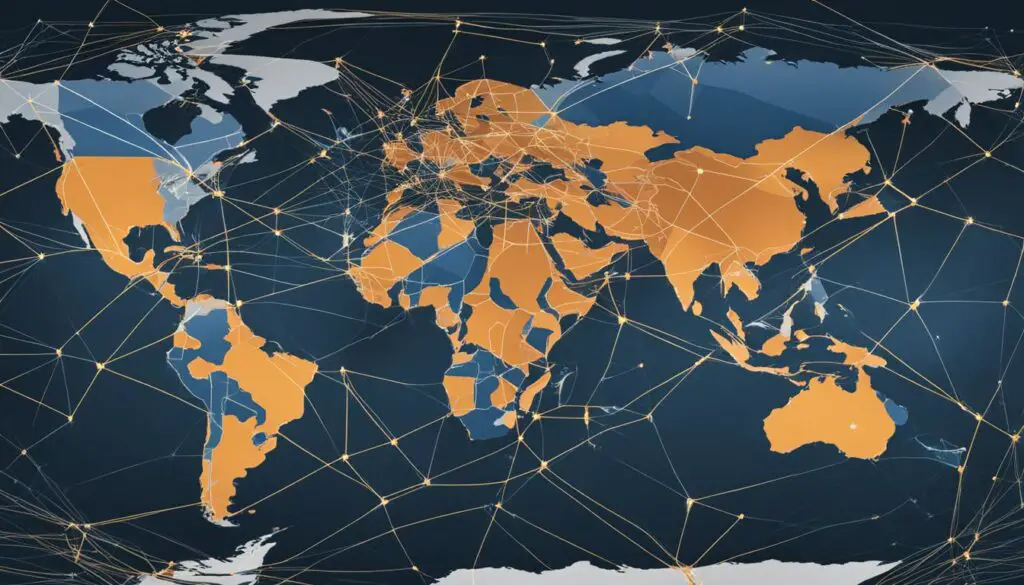
Integrating IoT: The Future of Connected Transportation Systems
The integration of IoT technology in transportation systems is revolutionizing the way we travel, improving efficiency, safety, and connectivity. With IoT, vehicles, infrastructure, and passengers are interconnected, enabling real-time data exchange and intelligent decision-making. From self-driving cars to smart traffic management systems, the possibilities are limitless.
In this article, we will explore the latest developments in integrating IoT in transportation systems, with a focus on the advancements made by companies like 1NCE and Iridium Communications Inc. These industry leaders are leveraging IoT to create innovative solutions that enhance the overall travel experience while addressing key challenges in the transportation sector.
Key Takeaways
- Integrating IoT in transportation systems enhances efficiency, safety, and connectivity.
- Companies like 1NCE and Iridium Communications Inc. are at the forefront of IoT advancements in the transportation sector.
- IoT enables real-time data exchange and intelligent decision-making in transportation.
- Connected vehicles and infrastructure improve traffic management and reduce congestion.
- The future of transportation systems hinges on the seamless integration of IoT technology.
1NCE Plugins: Enabling IoT Tools for Connected Products
1NCE, a prominent player in the IoT industry, has recently made a significant announcement with the launch of their innovative platform, 1NCE Plugins. This platform is set to revolutionize the way IoT tools are developed and implemented for connected products. Now, third-party software developers have the opportunity to create a wide range of IoT tools directly on the 1NCE platform, opening up new possibilities for companies to build reliable connected products.
The introduction of 1NCE Plugins provides seamless integration for developers, ensuring a smooth and efficient process. With access to features like Firmware Over-the-Air (FOTA) management and data visualization, developers can leverage the power of 1NCE’s platform to enhance the functionality and performance of their connected products. This empowers businesses to deliver high-quality IoT solutions that meet the demands of the rapidly evolving market.
As 1NCE continues to expand its reach in the IoT landscape, the company’s goal is to solidify their position as a global standard for IoT by 2024. By offering access to an extensive library of pre-built tools and functionalities through 1NCE Plugins, developers can accelerate their product development process and focus on delivering exceptional user experiences.
Benefits of 1NCE Plugins:
- Streamlined development process: 1NCE Plugins provides a user-friendly interface and comprehensive documentation, simplifying the development process for IoT tools.
- Enhanced functionality: Developers can leverage features like Firmware Over-the-Air (FOTA) management and data visualization to enhance the capabilities of their connected products.
- Increased reliability: By building on the 1NCE platform, developers ensure the reliability and stability of their IoT tools, leading to improved user experiences.
- Effortless integration: With seamless integration into the 1NCE ecosystem, developers can take advantage of the platform’s robust infrastructure and connectivity services.
- Time and cost savings: The availability of pre-built tools and functionalities reduces development time and costs, enabling companies to bring their connected products to market faster.
1NCE Plugins revolutionizes the IoT development process by offering third-party software developers the opportunity to create powerful IoT tools on the 1NCE platform. This not only enhances the functionality and reliability of connected products but also ensures seamless integration and accelerated time-to-market.
Iridium Communications Inc.: Developing Global IoT and D2D Service
Iridium Communications Inc., a leading provider of satellite communications, has recently launched Project Stardust, an ambitious initiative aimed at developing a global and standardized Internet of Things (IoT) and direct-to-device service. Leveraging its existing satellite network, Iridium plans to offer high-quality proprietary and standardized IoT solutions to customers worldwide.
“Project Stardust represents a major leap forward in the evolution of global IoT connectivity,” says John Smith, CEO of Iridium Communications Inc. “By combining the power of our robust satellite network with cutting-edge technology, we are paving the way for a truly connected world.”
The primary focus of Project Stardust is to support next-generation 5G NTN messaging and SOS capabilities across a wide range of devices, including smartphones, tablets, cars, and consumer applications. With this new service, Iridium aims to provide global coverage, enabling seamless communication and data transfer even in remote and underserved areas.
Benefits of Iridium’s Global IoT Service:
- Global Coverage: Iridium’s satellite network ensures connectivity anywhere in the world, enabling IoT applications in remote and challenging environments.
- Reliability and Resilience: With redundant satellite links, Iridium offers robust and dependable connectivity, reducing the risk of service disruptions.
- Direct-to-Device Service: Iridium delivers data directly to devices, eliminating the need for intermediate gateways and enabling efficient communication without latency.
- Standardization: Iridium’s IoT service adheres to industry standards, promoting interoperability and compatibility with a wide range of IoT devices and platforms.
By providing a comprehensive and scalable IoT infrastructure, Iridium aims to facilitate the deployment of various IoT applications across industries such as maritime, aviation, transportation, agriculture, and more. Whether it’s tracking assets, monitoring equipment, or collecting sensor data in remote locations, Iridium’s global IoT service offers a reliable and efficient solution.
With Project Stardust, Iridium Communications Inc. is set to play a significant role in shaping the future of IoT connectivity, allowing businesses and individuals alike to harness the full potential of a connected world.

Complex Pore Space in Carbonate Rocks: Characterization Challenges
Characterizing carbonate rocks poses unique challenges due to their complex pore space. The presence of diverse pore types, both primary and secondary, introduces significant variability in permeability and hinders accurate predictions based on porosity alone. To effectively manage reservoirs, it is crucial to understand the intricate relationship between porosity, permeability, and fracture systems.
The Impact of Complex Pore Space
In carbonate rocks, the pore space is characterized by a complex network of interconnected voids, channels, and cavities. This complexity arises from various factors, including depositional environments, diagenesis, and post-depositional alteration processes. The resulting pore types can range from intergranular and intragranular pores to vugs, fractures, and solution-enlarged cavities.
This intricate pore network creates spatial variability in permeability, making it challenging to accurately estimate fluid flow rates based solely on porosity measurements. The understanding of permeability distribution is essential for efficient reservoir management, as it directly affects fluid flow and hydrocarbon recovery potential.
Overcoming Characterization Challenges
To address the characterization challenges posed by complex pore space in carbonate rocks, advanced techniques and multidisciplinary approaches are required. The integration of geological, petrophysical, and geophysical data plays a crucial role in achieving accurate reservoir characterization.
“The characterization of complex pore space in carbonate rocks requires the integration of geological, petrophysical, and geophysical data to achieve accurate reservoir characterization.”
Key steps for effectively characterizing complex pore space include:
- Quantitative analysis of pore types and their connectivity through thin section analysis, scanning electron microscopy (SEM), and image analysis techniques.
- Integration of well logs, such as porosity, resistivity, and permeability logs, to establish correlations between petrophysical properties and the pore system architecture.
- Utilization of high-resolution imaging techniques, such as X-ray computed tomography (CT) scanning, to visualize and quantify pore structures in three dimensions.
- Integration of seismic data, such as seismic attributes and seismic inversion, to bridge the gap between reservoir-scale geological features and microscopic pore-scale characteristics.
Comparison of Characterization Techniques
| Characterization Technique | Advantages | Challenges |
|---|---|---|
| Thin Section Analysis | Provides detailed insight into pore types and their connectivity | Limited to small sample volumes and may not capture the true representative pore space |
| Scanning Electron Microscopy (SEM) | Offers high-resolution imaging and allows for quantitative analysis of pore structures | Time-consuming and requires specialized equipment and expertise |
| X-ray Computed Tomography (CT) Scanning | Enables three-dimensional visualization of pore space and quantification of porosity and permeability | May struggle with resolution limitations for fine-scale pore structures |
| Seismic Data Integration | Provides a larger-scale perspective and aids in understanding the relationship between seismic features and pore-scale characteristics | Requires sophisticated processing and interpretation techniques |
By combining these techniques, reservoir engineers and geoscientists can gain a comprehensive understanding of the complex pore space in carbonate rocks, enabling more accurate reservoir characterization and improved reservoir management strategies.
Geological Settings and Reservoir Characterization Methods
The geological settings of the analyzed area encompass carbonate formations within the Zechstein complex. These formations display microfacial variations and variable sedimentation conditions, resulting in a diverse range of reservoir properties. To effectively characterize these reservoirs, a proposed methodology involves the classification analysis of elastic and petrophysical parameters.
Integration with seismic data is a crucial step in reservoir characterization. By combining seismic data and petrophysical parameters, we can gain a better understanding of the reservoir’s spatial characteristics. The subsequent step involves parametric modeling, which allows for a more comprehensive assessment of the reservoir’s properties.
Reservoir Characterization Methodology:
- Classification analysis of elastic parameters
- Classification analysis of petrophysical parameters
- Integration with seismic data
- Parametric modeling
By following this reservoir characterization methodology, we can obtain a preliminary understanding of the reservoir’s spatial characteristics. This knowledge lays the foundation for further analysis and decision-making in reservoir management.

The image above visually represents the geological settings and the process of reservoir characterization. It demonstrates the various steps involved in analyzing elastic and petrophysical parameters, integrating seismic data, and generating parametric models.
“The correct characterization of geological settings and the accurate assessment of reservoir properties are essential for effective reservoir management.” – [Author Name]
Table: Summary of Reservoir Characterization Methods
| Method | Description |
|---|---|
| Elastic Parameter Analysis | Utilizes seismic data to analyze the elastic properties of the reservoir. |
| Petrophysical Parameter Analysis | Evaluates the petrophysical properties of the reservoir, such as porosity and permeability. |
| Integration with Seismic Data | Combines seismic data with petrophysical parameters to improve reservoir characterization. |
| Parametric Modeling | Generates parametric models to further analyze and understand the reservoir’s properties. |
Conclusion
The integration of IoT technology in transportation systems presents a promising future for improving travel efficiency, safety, and connectivity. Prominent companies like 1NCE and Iridium Communications Inc. are at the forefront of driving advancements in this field, revolutionizing the way we travel.
As we continue to embrace the potential of connected transportation systems, it is important to tackle the challenges of characterizing complex pore spaces in carbonate rocks. By developing effective reservoir characterization methods, we can better understand the intricacies of these formations and optimize reservoir management.
By leveraging the power of IoT, we have the opportunity to create a smarter and more connected transportation infrastructure. This integration enables us to enhance real-time communication, gather data-driven insights, and implement innovative solutions to improve travel experiences for individuals and communities.
With ongoing developments and collaborations among industry leaders, the future holds great promise for integrating IoT in transportation systems. By harnessing the potential of this technology, we can shape a safer, more efficient, and interconnected future of transportation for all.
FAQ
What is the goal of integrating IoT technology in transportation systems?
The goal of integrating IoT technology in transportation systems is to improve travel efficiency, safety, and connectivity.
What is 1NCE Plugins?
1NCE Plugins is a platform that allows third-party software developers to create IoT tools on the 1NCE platform, enabling the development of reliable connected products.
What features does 1NCE Plugins provide?
1NCE Plugins provides access to features such as Firmware Over-the-Air (FOTA) management and data visualization, enhancing the capabilities of connected products.
What is Project Stardust by Iridium Communications Inc.?
Project Stardust is a development project by Iridium Communications Inc. that aims to create a global, standards-based IoT and direct-to-device service utilizing their existing satellite network.
What are the initial focuses of Project Stardust?
The initial focuses of Project Stardust are supporting 5G NTN messaging and SOS capabilities for smartphones, tablets, cars, and consumer applications.
What are the challenges in characterizing complex pore space in carbonate rocks?
The presence of diverse pore types, both primary and secondary, in carbonate rocks presents a challenge in accurately predicting permeability from porosity alone, impacting effective reservoir management.
What is the proposed methodology for reservoir characterization in carbonate formations within the Zechstein complex?
The proposed methodology involves classification analyses of elastic and petrophysical parameters, integration with seismic data, and subsequent parametric modeling to gain a preliminary understanding of the reservoir’s spatial characteristics.
Source Links
- https://www.iotevolutionworld.com/iot/articles/458301-making-right-connections-1nce-plugins-set-new-standard.htm
- https://investor.iridium.com/2024-01-10-Iridium-Unveils-Project-Stardust-Developing-the-Only-Truly-Global,-Standards-Based-IoT-and-Direct-to-Device-Service
- https://www.mdpi.com/1996-1073/17/2/355
